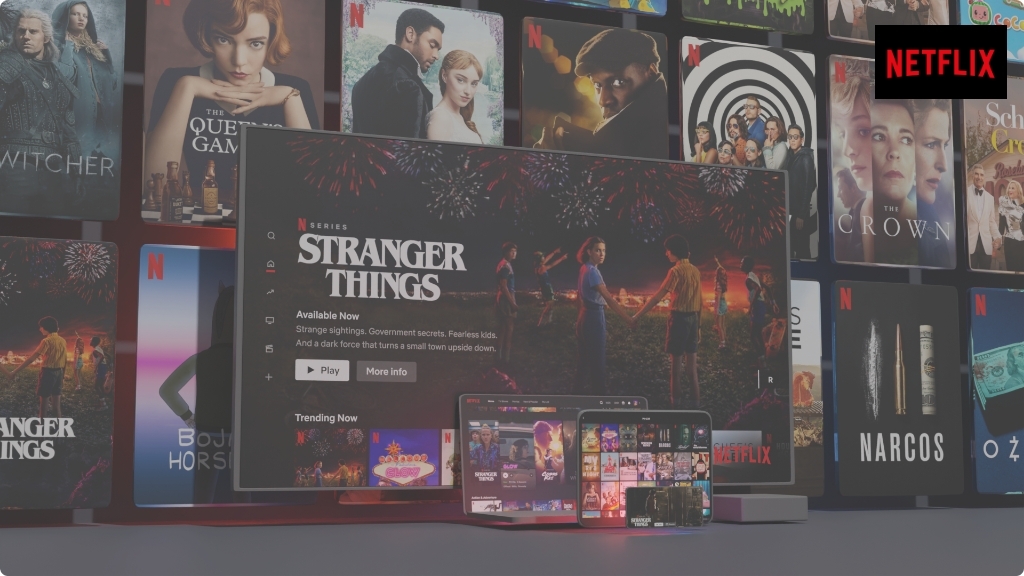Don't miss the chance to work with top 1% of developers.
Sign Up Now and Get FREE CTO-level Consultation.
Confused about your business model?
Request a FREE Business Plan.
Slack Business Model: The Secret Behind the Runaway Success of a Failed Product
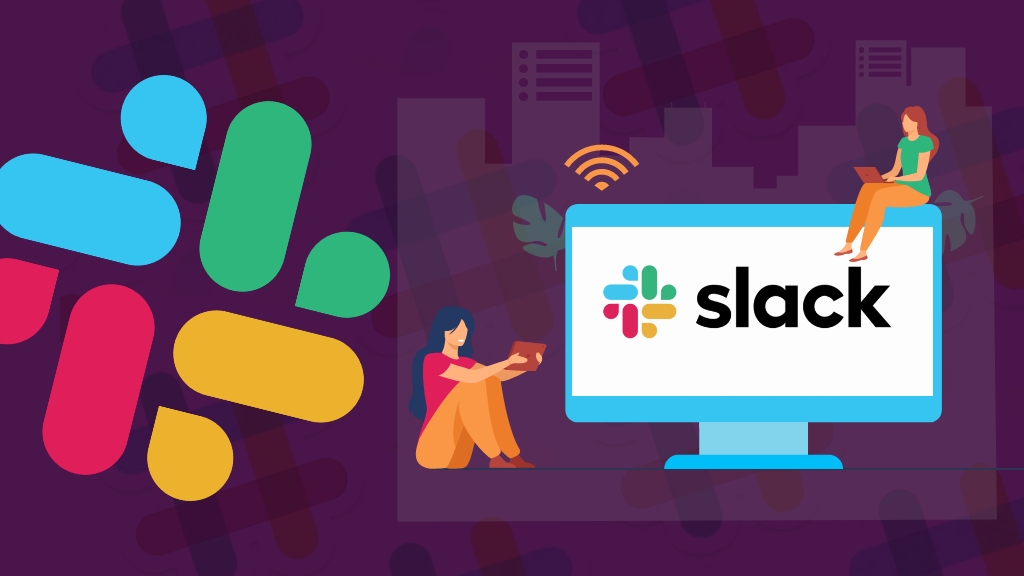
It would not be wrong if we say Slack is the by-product of two people juggling to make their names in the online gaming space. Yes, you heard it right. Slack, which is the fastest-growing SAAS startup today, wasn’t created willingly by its founders.
It is famous in the business world for reaching a valuation of $1 Billion just after the eight months of its launch and that too without any marketing efforts. Can you imagine, is that even possible? Well, yes it is.
Sometimes, a little luck combined with sheer determination can do wonders in the business world. Slack was a runaway success because its founders were determined to do something new and massive for the world. They were trying to make their names in the online multiplayer game market but ended by revolutionizing how people communicate at work.
In this blog, we will talk about the Slack business model, its inspirational story, how does slack work, and what’s the secret sauce behind its massive success. So, let’s get started with a few facts and stats.
Slack Stats and Facts: Funding and Major Milestones
- Founded/launched: 14 August 2013
- Headquarters: San Francisco, California
- Founders: Stewart Butterfield and Cal Henderson
- Total Customers (as of 2019): 12 Million
- Paying Customers (as of 2021): 156,000
- Big Brands using Slack: IBM, PayPal, Amazon, Airbnb, and many others.
- Acquired by: Salesforce
- Slack Business Model Type: Freemium
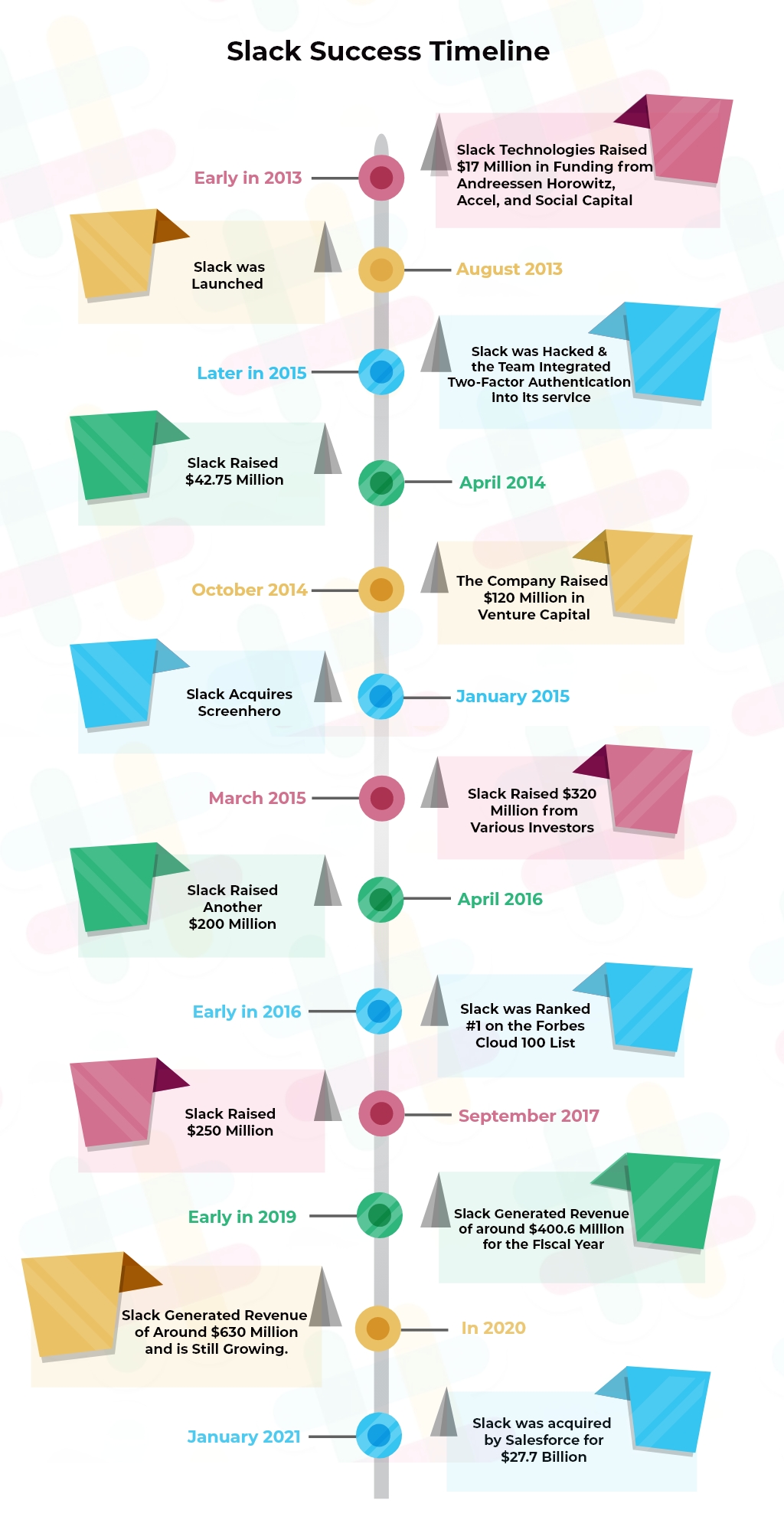
The Inspiring Success Story of Slack
Slack’s success story revolves around pivoting a failed gaming project into a successful tech product. It was actually born as a byproduct of a gaming company called Tiny Speck. In 2011, this company launched Glitch, a gaming app that failed to gain any traction. However, because its development team was distributed in three remote locations, they built an app to communicate online efficiently when developing Glitch.
The team was itself amazed by the potential of that app and after the failure of Glitch, they began developing the communication app full-time, which is today known as Slack.
Initially, after beta testing the application with a couple of organizations, Stewart Butterfield (CEO and co-founder of Slack) realized the potential of Slack as a response to the numerous different ways employees communicated using it. He felt amazed after seeing how everything could be possible through one application instead of spending hours in meetings, crafting emails, and making phone calls.
Following a year of secretly testing the application, Slack was released to the public in February 2014. It became an amazing success, getting 8,000 registrations on the first day and 15,000 after the second week. The users were increasing to an extent that Slack needed to stagger the release, as it added more servers to fulfill the growing need.
As Slack’s users were increasing rapidly, word of mouth increased the demand further. Numerous media associations were quick to use the application and they wrote positively about it. It developed at a pace of 5-10% a week in the first year. Slack achieved unicorn status in 2014, and its worth nearly trebled the following year when it was valued at $2.8 B.
Slack’s initial few years were driven by the application’s UX, which was simpler and beautiful as compared to other eminent online chat tools like Campfire or Hipchat available at that time. In 2016, Slack released a bunch of new features to get a competitive edge in the market, including an application and bot. From that point onward, there is no looking back.
Here is how its user base increased over all these years:
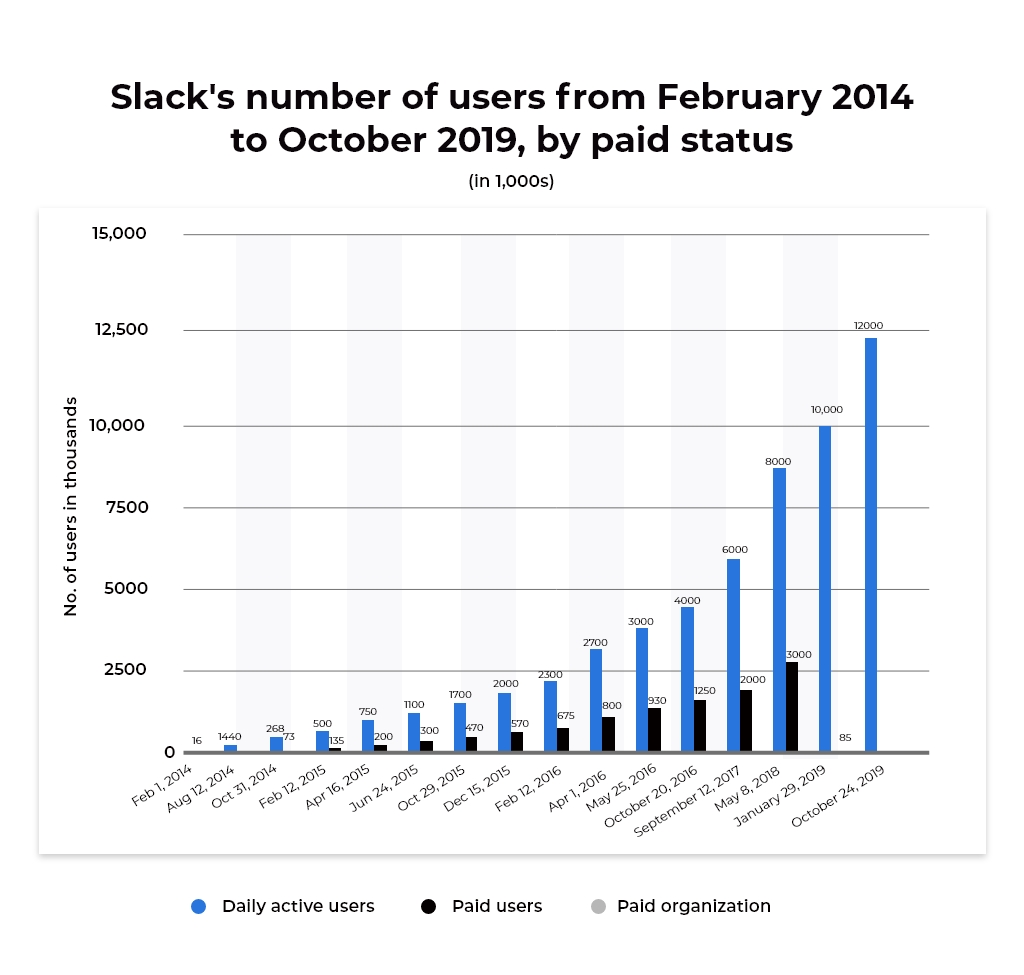
Now that we know the history of this fastest-growing startup called Slack – let’s move towards the next section and analyze Slack’s business model to find its secret sauce to success and how it brings money to the table.
Slack Business Model: The Way to Design a Billion-Dollar Product
Slack is an online messaging application that almost every workplace seems to be using these days. It is essentially a communication app on steroids that is intended for teams and workplaces to communicate and collaborate easily and effectively to improve productivity.
It tends to be utilized across numerous platforms and devices and comes with amazing features that permit you to talk one-on-one with associates as well as in groups.
Along with letting you communicate effectively, it also lets you upload and share files and integrate other apps and tools in one place so that you can save time and work efficiently. You can granularly control pretty much every setting and can even create custom emoticons to make work fun. A survey demonstrates that teams using Slack experienced some huge benefits, including:
- 48.6% decrease in email use
- 32% increase in team productivity
- 25.1% reduction in meetings
Its users also say that using Slack has improved their transparency and culture. With its various powerful features and third-party tools integration, Slack can undoubtedly transform into the focal center for all your group activities. It can even turn into a central point of your project management process.
Some of its interesting features include automated reminders, task-list management, powerful search capabilities, custom shortcuts, integration with other tools, audio, and video calls.
Let’s now find how it operates for providing such amazing features using Slack Business Model Canvas:
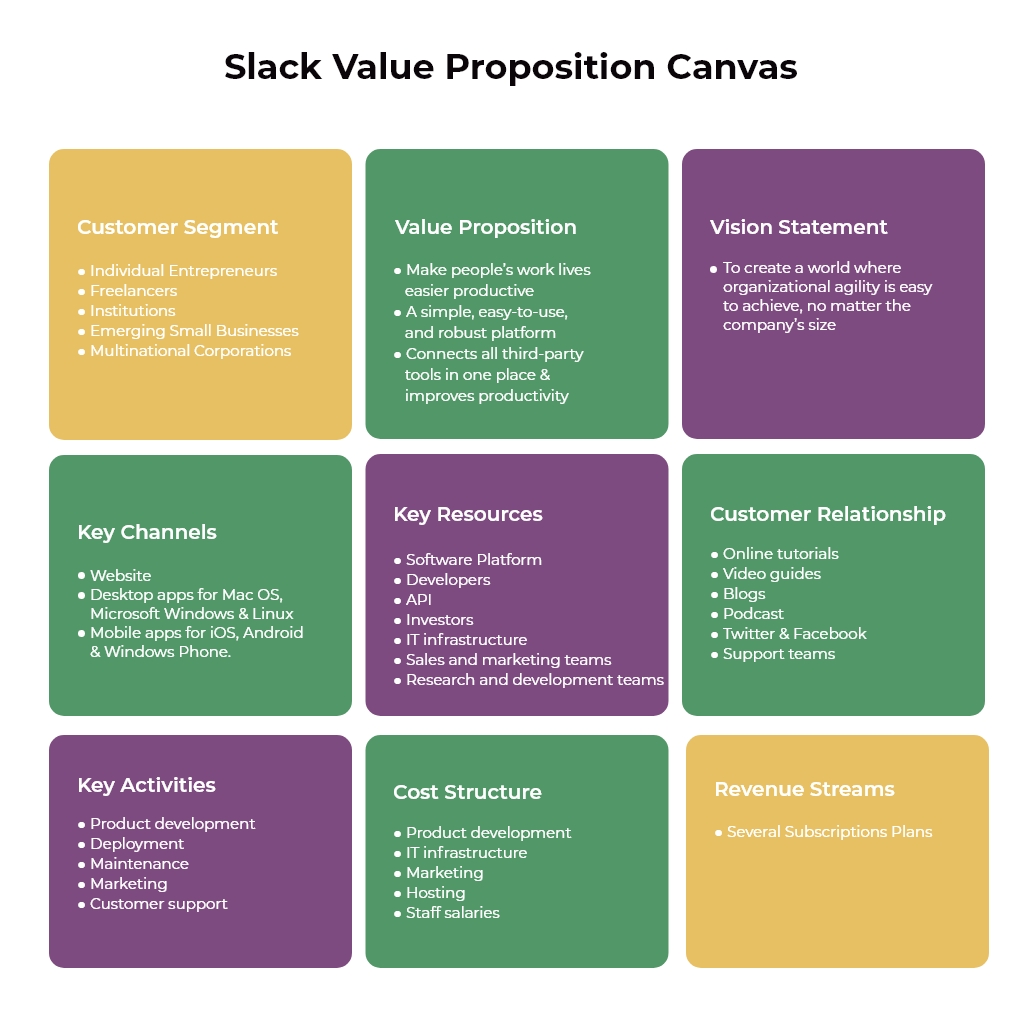
1) The company’s mission revolves around providing a SAAS platform to the world that increases a team’s productivity and efficiency while working on collaborative projects. And it is quite successful in achieving that.
2) The brand targets people who need to maintain frequent collaboration while working. May it be small businesses, freelancers, large enterprises, or budding entrepreneurs – it is designed and presented in a way that is suitable and useful for all.
3) Its user base isn’t just restricted to tech-savvy teams. In fact, because of having an easy-to-use interface, it also serves users from academic, travel, and retail spaces. Big brands using Slack include Linkedin, Airbnb, IBM, and many others.
4) Slack is a free-to-use app for basic users. By offering its services for free, the brand kills two birds with a single stone. It lets small teams use its product for free and increases its user base. On the other hand, larger teams can try out the product before going premium.
5) The product lets users fully customize its services by integrating a wide range of third-party tools inside the app for working seamlessly, which is one of the value propositions of Slack.
6) Slack’s app is available for desktop (Mac OS, Microsoft Windows & Linux) as well as mobile (Android and iOS). However, it can also be used inside a web browser.
7) The brand continuously invests in improving its product’s user experience and prefers word of mouth marketing to increase its users and eventually revenues.
So that was all about the Slack business model and how it works to serve its users and become a brand worth a billion dollars. Let’s now find how Slack brings money to the table using its amazing features and what budding entrepreneurs can learn from its success.

Slack Revenue Model: How Does Slack Make Money?
As mentioned earlier, Slack follows a freemium business model. This implies that a basic version is offered to users for free and they can convert themselves into paying users if they need to use advanced functionalities. It consolidates the free model with an immediate sales force to get premium and even enterprise-level customers.
As per Statista, the brand was having around 8 Million daily active users, out of which around 3 Million were paid ones. In 2019, Slack’s daily active users reached 10 Million and its paying customers are said to around 85,000 as per its official website.
It provides four plans, out of which one is free and three are paid:
- Free
- Standard
- Plus
- Enterprise Grid
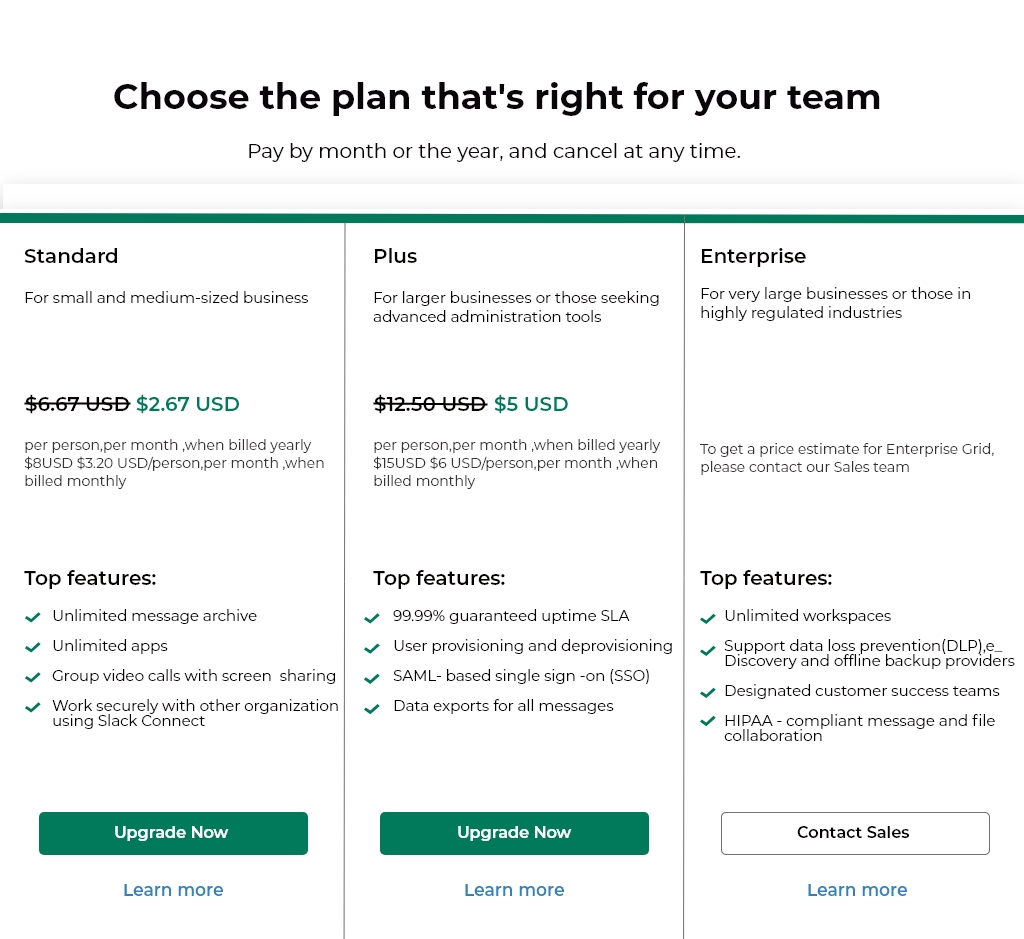
Its paid subscription plans are said to be the only source of revenue of the company as of now.
Small businesses can utilize Slack’s free membership to try and understand its benefits. Slack then provides more functionalities once these users become accustomed to it. Its amazing functionalities like shared channels, unlimited integration to third-party tools, saved messages, and guest accounts allure free users to become paying customers and that’s how the brand brings money to the table.
The Free, Standard, and Plus memberships plan provides a single workspace for small teams. The Enterprise Grid membership is for bigger teams. It has connected channels, more integrations, and efficient data security.
That’s how Slack makes money through paid memberships. These memberships are given either on a month-to-month or yearly basis, contingent on the number of an organization’s users on Slack.
Also Read: How Slack Got a 27 Billion Dollar Business Deal from Salesforce?
3 Lessons You Should Learn from Slack’s Success
1. If You are Failing – Just Pivot
Building a startup isn’t easy. At every point, you need to look upon challenges, opportunities, failures, and analyze what is going wrong and how is survival possible.
Imagine if Butterfield kept investing his efforts in Glitch rather than acknowledging its flaws, Slack would never have been developed. And, it is uncertain that what would have been the future of Glitch and his entire team. But, that didn’t happen.
The team saw they were struggling to make Glitch successful and took action. Instead of shutting the whole business down, they opted to take a different approach. They decided to pivot from investing in a failed product to launching a new commercial communication tool that is today known as Slack – the fastest growing SAAS product of all the time.
Similarly, if at any point you realize that you are failing, analyze whether you are putting your efforts in the wrong direction. Can you take something out from your failed company or product to make some profits? Could any of the features of your product be used and sold as a standalone product? Look in all directions and make a wise decision.
2. Take User Experience very Seriously
Though customers should be above all at every stage of your business, startups need to handle user experience very carefully.
Since as a startup, you will be new to the industry and a lot of people might not know all about your products and services. In such a situation, it becomes your responsibility to not give users a single chance of getting frustrated while using your product.
From its inception, Slack had listened cautiously to its users, assessing their feedback virtually all the time. Unlike many startups, Slack had a small user experience team of three individuals working all day to help new users.
This wasn’t only a ploy to increase the user base, yet another example of how Slack put the effort to truly nail the user experience to drive growth. By 2015, this team grew to 18 full-time employees, including six members offering 24/7 support through Twitter. Today, its customer experience team is the largest in the company and spread across all over the world so that users can always talk to a person if they have any queries.
3. A Perfect Product Launch Plan is a Win-Win
For a new product, a soft launch is always preferable. And, if it is used with word-of-mouth marketing and some early fans of the product, it becomes a game-changer.
Butterfield and his team started working on Slack in 2012. It was launched in 2013. However, before its official launch, Butterfield presented it to some friends and colleagues working in other companies and asked them to give it a try.
This helped them spread the word out about their product in the market before its official launch and this approach worked incredibly. On the release day, 8000 people registered on Slack, and in just 15 days that number grew to 15,000. After four months of the release, Slack acquired 1.1 Million active users.
4. Right Place + Right Time = A Win Win
Back in 2012, team communication was a problem for everyone. With the world going digital and new software products launching every day, Butterfield and his team realized that communication becomes a barrier when a single-digit team expands to more than 20 people. They also knew they had a large market (from massive enterprises to small startups) to target using their communication tool.
Though they were not the first communication app of their time – Campfire, HiChat, and Yammer were very popular back then. However, they realized the problems people used to face when using these apps. For example, to use Yammer teams were required to use Microsoft Office 365 which was paid.
So, Slack just solved the problem at the right time and with a better approach. They built a tool that is loved for its fun approach to work, a brilliant freemium business model, and integration with many apps.
Wrapping Up
Slack’s success story is inspiring and has many lessons for tech entrepreneurs that they can implement while setting up their own venture. It successfully uses a “Freemium business model” in a world dominated by advertisements. Slack attracts corporate users by offering a free, easy-to-use product and adds value to their lives.
The brand’s ability to align its business model around making user’s lives easy and productive will always reserve a place for it amongst the startup success stories for the years to come.

Rate this article!
(4 ratings, average: 3.25 out of 5)
Join 60,000+ Subscribers
Get the weekly updates on the newest brand stories, business models and technology right in your inbox.

Nikhil Bansal is the Founder and CEO of Apptunix, a leading Software Development Company helping startups as well as brands in streamlining their business processes with intuitive and powerful mobile apps. After working in the iOS app development industry for more than 10 years, he is now well-equipped with excellent problem-solving and decision-making techniques.

Telemedicine 2.0 - A Comprehensive Guide On What Healthcare Providers Need To Know?
Discover how the latest advancements like Artificial Intelligence in telemedicine are reshaping patient care. This comprehensive resource offers insights into the key trends and innovations driving this shift, providing valuable knowledge for healthcare professionals looking to stay ahead.
Download Now!